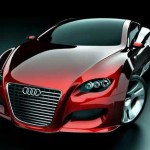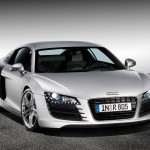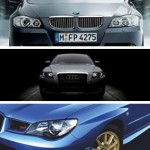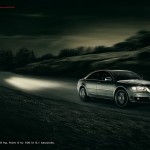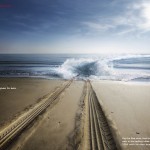Project 2 magazine spread Audi
Audi research pics
I will not include all the information that I found. I will focus on the ad campaign that Audi has been using in recent years to position themselves as the cool hip alternative to traditional luxury vehicles like BMW and Mercedes. I will do a cut away design to represent the vehicle. I will make 3 panels like the ad above except I will accent the cars design and personality with my design. I like the cleanness of all the images that I found. The images are consistent with the brand image that audi is trying to represent.
research
udi AG (Xetra: NSU) is a German manufacturer of a range of automobiles, from supermini to crossover SUVs in various body styles and price ranges that are marketed under the Audi brand (German pronunciation: [ˈaʊdi]), positioned as the premium brand within the Volkswagen Group.[3]The company is headquartered in Ingolstadt, Germany, and has been a wholly owned (99.55%[4]) subsidiary of Volkswagen AG since 1966, following a phased purchase of its predecessor, Auto Union, from its former owner, Daimler-Benz. Volkswagen relaunched the Audi brand with the 1965 introduction of the Audi F103 series.The company name is based on the surname of the founder August Horch, his surname meaning listen in German — which, when translated into Latin, becomes Audi.
Birth of the company and its name
Audi Type EOn November 14, 1899, August Horch (1868–1951) established the company A. Horch & Cie. in the Ehrenfeld district of Cologne, but because of dispute between him and the supervisory board, he had to leave the company. A few years later, he established a second company, Horch Automobil-Werke GmbH. The company traces its origins back to 1909 and August Horch. The first Audi automobile, the Audi Type A 10/22 hp (16 kW) Sport-Phaeton, was produced in 1910 in Zwickau.[5]In 1909, Horch was forced out of the company he had founded.[6] He then started a new company in Zwickau and continued using the Horch brand. His former partners sued him for trademark infringement, and the German Supreme Court (Reichsgericht in Berlin)[7] finally determined that the Horch brand belonged to his former company.[6]August Horch was barred from using his own family name in his new car business, so he called a meeting with his best business friends, Paul and Franz Fikentscher from Zwickau. At the apartment of Franz Fikentscher, they discussed how to come up with a new name for the company. During this meeting, Franz’s son was quietly studying Latin in a corner of the room. Several times he looked like he was on the verge of saying something but would just swallow his words and continue working, until he finally blurted out, “Father – audiatur et altera pars… wouldn’t it be a good idea to call it audi instead of horch?”[8] “Horch!” in German means “Hark!” or “hear”, which is “Audi” in Latin. The idea was enthusiastically accepted by everyone attending the meeting.[9] The first Audi car, the Type B, 10/28PS was delivered early in 1910.[10]Audi started with a 2612 cc inline-four engine model[clarification needed] followed by a 3564 cc model, as well as 4680 cc and 5720 cc models. These cars were successful even in sporting events. The first six cylinder model,[clarification needed] 4655 cc appeared in 1924.August Horch left the Audi company in 1920 for a high position at the ministry of transport, but he was still involved with Audi as a member of the board of trustees. In September 1921, Audi became the first German car manufacturer to present a production car, the Audi Type K, with left-handed drive.[11] Left-hand drive spread and established dominance during the 1920s because it provided a better view of oncoming traffic, making overtaking safer.[11][edit]Auto Union eraMain article: Auto Union
In August 1928 Jørgen Rasmussen, the owner of Dampf-Kraft-Wagen (DKW), acquired the majority of shares in Audiwerke AG.[12] In the same year, Rasmussen bought the remains of the U.S. automobile manufacturer Rickenbacker, including the manufacturing equipment for eight cylinder engines. These engines were used in Audi Zwickau and Audi Dresden models that were launched in 1929. At the same time, six-cylinder and four-cylinder (licensed from Peugeot) models were manufactured. Audi cars of that era were luxurious cars equipped with special bodywork.In 1932, Audi merged with Horch, DKW, and Wanderer, to form Auto Union. It was during this period that the company offered the Audi Front that became the first European car to combine a six-cylinder engine with front-wheel drive. It used a powertrain shared with the Wanderer, but turned 180-degrees, so that the drive shaft faced the front.Before World War II, Auto Union used the four interlinked rings that make up the Audi badge today, representing these four brands. This badge was used, however, only on Auto Union racing cars in that period while the member companies used their own names and emblems. The technological development became more and more concentrated and some Audi models were propelled by Horch or Wanderer built engines.Reflecting the economic pressures of the time, Auto Union concentrated increasingly on smaller cars through the 1930s, so that by 1938 the company’s DKW brand accounted for 17.9% of the German car market while Audi held only 0.1%.[edit]Post-World War IILike most German manufacturing, at the onset of World War II the Auto Union plants were retooled for military production, and were a target for allied bombing during the war, leaving them damaged.Overrun by the Soviet Army in 1945, on the orders of the Soviet Union military administration the factories were dismantled as part of war reparations.[13] Following this, the company’s entire assets were expropriated without compensation.[13] On 17 August 1948, Auto Union AG of Chemnitz was deleted from the commercial register.[12] These actions had the effect of liquidating Germany’s Auto Union AG. The remains of the Audi plant of Zwickau became the VEB (for “People Owned Enterprise”) Automobilwerk Zwickau or AWZ (in English: Automobile Works Zwickau).[14]The former Audi factory in Zwickau restarted assembly of the pre-war-models in 1949. These DKW models were renamed to IFA F8 and IFA F9 and were similar to the West German versions. West and East German models were equipped with the traditional and renowned DKW two-stroke engines.[edit]New Auto UnionA new West German headquartered Auto Union was launched in Ingolstadt, Bavaria with loans from the Bavarian state government and Marshall Plan aid.[15] The reformed company was launched 3 September 1949 and continued DKW’s tradition of producing front-wheel drive vehicles with two-stroke engines.[13] This included production of a small but sturdy 125 cc motorcycle and a DKW delivery van, the DKW F 89 L at Ingolstadt. The Ingolstadt site was large, consisting of an extensive complex of formerly military buildings which was suitable for administration as well as vehicle warehousing and distribution, but at this stage there was at Ingolstadt no dedicated plant suitable for mass production of automobiles: for manufacturing the company’s first post-war mass-market passenger car plant capacity in Düsseldorf was rented from Rheinmetall-Borsig. It was only ten years later, after the company had attracted an investor that funds became available for construction of major car plant at the Ingolstadt head office site.In 1958 Daimler-Benz took an 87% holding in the Auto Union company, and this was increased to a 100% holding in 1959. However, small two-stroke cars were not the focus of the company’s interests, and while the early 1960s saw major investment in new Mercedes models and in a state of the art factory for Auto Union’s, the company’s aging model range at this time did not benefit from the economic boom of the early 1960s to the same extent as competitor manufacturers such as Volkswagen and Opel. The decision to dispose of the Auto Union business was based on its lack of profitability.[16] Ironically, by the time they sold the business it also included a large new factory and near production-ready modern four-stroke engine, which would enable the Auto Union business, under a new owner and with the benefit of a rediscovered name, Audi.In 1964 Volkswagen acquired a 50% holding in the business, which included the new factory in Ingolstadt and the trademark rights of the Auto Union. Eighteen months later, Volkswagen bought complete control of Ingolstadt, and by 1966 were using the spare capacity of the Ingolstadt plant to assemble an additional 60,000 Volkswagen Beetles per year.[17] Two-stroke engines became less popular during the 1960s as customers were more attracted to the smoother four-stroke engines. In September 1965, the DKW F102 was fitted with a four-stroke engine and a facelift for the car’s front and rear. Volkswagen dumped the DKW brand because of its associations with two-stroke technology, and having classified the model internally as the F103, sold it simply as the “Audi.” Later developments of the model were named for their horsepower ratings and sold as the Audi 60, 75, 80, and Super 90, selling until 1972.
Audi 80 assembly line in Wolfsburg as of 1973In 1969, Auto Union merged with NSU, based in Neckarsulm, near Stuttgart. In the 1950s, NSU had been the world’s largest manufacturer of motorcycles, but had moved on to produce small cars like the NSU Prinz, the TT and TTS versions of which are still popular as vintage race cars. NSU then focused on new rotary engines based on the ideas of Felix Wankel. In 1967, the new NSU Ro 80 was a car well ahead of its time in technical details such as aerodynamics, light weight, and safety. However, teething problems with the rotary engines put an end to the independence of NSU. The Neckarsulm plant is now used to produce the larger Audi models A6 and A8. The Neckarsulm factory is also home of the quattro GmbH, a subsidiary responsible for development and production of Audi high-performance models: the R8 and the “RS” model range.The mid-sized car that NSU had been working on, the K70, was intended to slot between the rear-engined Prinz models and the futuristic NSU Ro 80. However, Volkswagen took the K70 for its own range, spelling the end of NSU as a separate brand.[edit]Modern eraThe new merged company was known as Audi NSU Auto Union AG, and saw the emergence of Audi as a separate brand for the first time since the pre-war era. Volkswagen introduced the Audi brand to the United States for the 1970 model year.The first new car of this regime was the Audi 100 of 1968. This was soon joined by the Audi 80/Fox (which formed the basis for the 1973 Volkswagen Passat) in 1972 and the Audi 50 (later rebadged as the Volkswagen Polo) in 1974. The Audi 50 was a seminal design because it was the first incarnation of the Golf/Polo concept, one that led to a hugely successful world car.
Audi QuattroThe Audi image at this time was a conservative one, and so, a proposal from chassis engineer Jörg Bensinger[18] was accepted to develop the four-wheel drive technology in Volkswagen’s Iltis military vehicle for an Audi performance car and rally racing car. The performance car, introduced in 1980, was named the “Audi Quattro”, a turbocharged coupé which was also the first German large-scale production vehicle to feature permanent all-wheel drive through a centre differential. Commonly referred to as the “Ur-Quattro” (the “Ur-” prefix is a German augmentative used, in this case, to mean “original” and is also applied to the first generation of Audi’s S4 and S6 Sport Saloons, as in “UrS4” and “UrS6”), few of these vehicles were produced (all hand-built by a single team), but the model was a great success in rallying. Prominent wins proved the viability of all-wheel drive racecars, and the Audi name became associated with advances in automotive technology.In 1985, with the Auto Union and NSU brands effectively dead, the company’s official name was now shortened to simply Audi AG.In 1986, as the Passat-based Audi 80 was beginning to develop a kind of “grandfather’s car” image, the type 89 was introduced. This completely new development sold extremely well. However, its modern and dynamic exterior belied the low performance of its base engine, and its base package was quite spartan (even the passenger-side mirror was an option.) In 1987, Audi put forward a new and very elegant Audi 90, which had a much superior set of standard features. In the early 1990s, sales began to slump for the Audi 80 series, and some basic construction problems started to surface.
Audi R8In the early part of the 21st century, Audi set forth on a German racetrack to claim and maintain several World Records, such as Top Speed Endurance. This effort was in-line with the company’s heritage from the 1930s racing era Silver Arrows.Sales fell after a series of recalls from 1982-1987 of Audi 5000 models[19] associated with reported incidents of sudden unintended acceleration linked to six deaths and 700 accidents.[19] At the time, NHTSA was investigating 50 car models from 20 manufacturers for sudden surges of power.[20]A 60 Minutes report aired 23 November 1986,[21] featuring interviews with six people who had sued Audi after reporting unintended acceleration, showing an Audi 5000 ostensibly suffering a problem when the brake pedal was pushed.[22][23] Subsequent investigation revealed that 60 Minutes had engineered the failure — fitting a canister of compressed air on the passenger-side floor, linked via a hose to a hole drilled into the transmission.[21]Audi contended, prior to findings by outside investigators,[20] that the problems were caused by driver error, specifically pedal misapplication.[20] Subsequently, the National Highway Traffic Safety Administration (NHTSA) concluded that the majority of unintended acceleration cases, including all the ones that prompted the 60 Minutes report, were caused by driver error such as confusion of pedals.[24] CBS did not acknowledge the test results of involved government agencies, but did acknowledge the similar results of another study.[22]With the series of recall campaigns, Audi made several modifications; the first adjusted the distance between the brake and accelerator pedal on automatic-transmission models.[19] Later repairs, of 250,000 cars dating back to 1978, added a device requiring the driver to press the brake pedal before shifting out of park.[19] A legacy of the Audi 5000 and other reported cased of sudden unintended acceleration are intricate gear stick patterns and brake interlock mechanisms to prevent inadvertent shifting into forward or reverse.Audi’s U.S. sales, which had reached 74,061 in 1985, dropped to 12,283 in 1991 and remained level for three years.[19] — with resale values falling dramatically.[25] Audi subsequently offered increased warranty protection [25] and renamed the affected models — with the 5000 becoming the 100 and 200 in 1989[20] — and only reached the same sales levels again by model year 2000.[19]A 2010 BusinessWeek article — outlining possible parallels between Audi’s experience and 2009–2010 Toyota vehicle recalls — noted a class-action lawsuit filed in 1987 by about 7,500 Audi Audi 5000-model owners remains unsettled and is currently being contested in county court in Chicago after appeals at the Illinois state and U.S. federal levels.[19][edit]Audi AG today
Audi plant in Aurangabad, IndiaThe largest shareholder of Audi AG is Volkswagen AG, which holds over 99 percent of the share capital. Volkswagen AG includes the consolidated accounts of Audi AG in its own consolidated financial statements. In recent years, the possibility of Audi being spun off or otherwise divested by Volkswagen has been mooted [26]From 2002 up to 2007, Audi headed the Audi Brand Group, the Volkswagen Group’s automotive sub-division, consisted of Audi together with SEAT and Lamborghini, that was focused on more sporty values, with the marques’ product vehicles and performance being under the higher responsibility of the Audi brand.[27][28][29]Audi’s sales grew strongly in the 2000s, with deliveries to customers increasing from 653,000 in 2000 to 1,003,000 in 2008. The largest sales increases came from Eastern Europe (+19.3%), Africa (+17.2%) and the Middle East (+58.5%). China in particular has become a key market, representing 108,000 out of 705,000 cars delivered in the first three quarters of 2009. One factor for its popularity is China is that Audis have become the car of choice for purchase by the Chinese government for officials, and purchases by the government are responsible for 20% of its sales in China.[30] As of late 2009, Audi’s operating profit of €1.17-billion ($1.85-billion) made it the biggest contributor to parent Volkswagen Group’s nine-month operating profit of €1.5-billion, while the other marques in Group such as Bentley and Seat had suffered considerable losses.[31]Audi has 6 manufacturing plants around the world: Ingolstadt, Germany since 1969, Neckarsulm, Germany since 1969, Györ, Hungary, Changchun, China since 1995, Brussels, Belgium since 2007, Aurangabad, India since 2006.[32][edit]Technology
This section does not cite any references or sources.Please help improve this article by adding citations to reliable sources. Unsourced material may be challenged and removed. (June 2008)[edit]BodyshellsAudi produces 100% galvanised cars to prevent corrosion,[33] and was the first mass-market vehicle to do so, following introduction of the process by Porsche, c.1975. Along with other precautionary measures, the full-body zinc coating has proved to be very effective in preventing rust. The body’s resulting durability even surpassed Audi’s own expectations, causing the manufacturer to extend its original 10-year warranty against corrosion perforation to currently 12 years (except for aluminium bodies which don’t rust).[34]An all-aluminium car was brought forward by Audi, and in 1994 the Audi A8 was launched, which introduced aluminium space frame technology (called Audi Space Frame). Audi introduced a new series of vehicles in the mid-nineties and continues to pursue leading-edge technology and high performance. Prior to that effort, Audi used examples of the Type 44 chassis fabricated out of aluminium as test-beds for the technique.[edit]Drive layoutIn all its post Volkswagen-era models, Audi has firmly refused to adopt the traditional rear-wheel drive layout favoured by its two arch rivals Mercedes-Benz and BMW, favouring either front-wheel drive or all wheel drive. To achieve this, Audi has usually engineered its cars with a longitudinally front mounted engine, in an “overhung” position, over the front wheels in front of the axle line. While this allows for the easy adoption of all wheel drive, it goes against the ideal 50:50 weight distribution (as do all front wheel drive cars).Audi has recently applied the quattro badge to models such as the A3 and TT which do not use the Torsen-based system as in prior years, with a mechanical centre differential, but with the Swedish Haldex Traction electro-mechanical clutch AWD system.[edit]EnginesIn the 1980s, Audi, along with Volvo, was the champion of the inline 5 cylinder, 2.1/2.2 L engine as a longer-lasting alternative to more traditional 6 cylinder engines. This engine was used not only in production cars but also in their race cars. The 2.1 L inline 5 cylinder engine was used as a base for the rally cars in the 1980s, providing well over 400 horsepower (298 kW) after modification. Before 1990, there were engines produced with a displacement between 2.0 L and 2.3 L. This range of engine capacity allowed for both fuel economy and power.[edit]CompetitorsThrough the early 1990s, Audi began to move shift its target market upscale to compete against German automakers Mercedes-Benz and BMW. This began with the release of the Audi V8 in 1990. It was essentially a new engine fitted to the Audi 100/200, but with noticeable bodywork differences. Most obvious was the new grille that was now incorporated in the bonnet.By 1991, Audi had the 4 cylinder Audi 80, the 5 cylinder Audi 90 and Audi 100, the turbocharged Audi 200 and the Audi V8. There was also a coupe version of the 80/90 with both 4 and 5 cylinder engines.Although the five cylinder engine was a successful and robust powerplant, it was still a little too different for the target market. With the introduction of an all-new Audi 100 in 1992, Audi introduced a 2.8L V6 engine. This engine was also fitted to a face-lifted Audi 80 (all 80 and 90 models were now badged 80 except for the USA), giving this model a choice of 4, 5, and 6-cylinder engines, in Saloon, Coupé and Cabriolet body styles.The 5-cylinder was soon dropped as a major engine choice; however, a turbocharged 230 hp (169 kW) version remained. The engine, initially fitted to the 200 quattro 20V of 1991, was a derivative of the engine fitted to the Sport Quattro. It was fitted to the Audi Coupé, and named the S2 and also to the Audi 100 body, and named the S4. These two models were the beginning of the mass-produced S series of performance cars.[edit]Space frameThe Audi A8 replaced the V8 in 1994, with an aluminium space frame, known as the “Audi Space Frame” (ASF), to save weight. The weight reduction was offset by the quattro four-wheel drive system. It meant the car had similar performance to its rivals, but superior roadholding. The Audi A2, Audi TT and Audi R8 also use Audi Space Frame designs.[edit]Audi A2The Audi A2 was a futuristic super mini born from the Al2 concept. It featured many features that gave Audi the cutting edge technology that it had lacked for years, like the aluminium space frame which was a first in production car design. In the A2 Audi further expanded their TDI technology through the use of frugal three cylinder engines. The A2 was extremely aerodynamic and was designed around a wind tunnel. The Audi A2 was criticised for its high price and was never really a sales success but it planted Audi as a cutting edge manufacturer. The model, a Mercedes-Benz A-Class competitor, sold relatively well in Europe. However, the A2 was discontinued in 2005 and Audi decided not to develop an immediate replacement.[edit]Audi A4The next major model change came in 1995 when the Audi A4 replaced the Audi 80. The new nomenclature scheme was applied to the Audi 100 to become the Audi A6 (with a minor facelift). This also meant the S4 became the S6 and a new S4 was introduced in the A4 body. The S2 was discontinued. The Audi Cabriolet continued on (based on the Audi 80 platform) until 1999, gaining the engine upgrades along the way. A new A3 hatchback model (sharing the Volkswagen Golf Mk4’s platform) was introduced to the range in 1996, and the radical Audi TT coupé and roadster were debuted in 1998 based on the same underpinnings.The engines available throughout the range were now a 1.4L, 1.6L and 1.8L 4 cylinder, 1.8L 4-cylinder turbo, 2.6L and 2.8L V6, 2.2L turbo-charged 5 cylinder and the 4.2L V8 engine. The V6s were replaced by new 2.4L and 2.8L 30V V6s in 1998, with marked improvement in power, torque and smoothness. Further engines were added along the way, including a 3.7L V8 and 6.0L W12 engine for the A8.[edit]Direct-Shift GearboxAt the turn of the century, Volkswagen introduced the Direct-Shift Gearbox (DSG), a type of dual clutch transmission. It is an automated semi-automatic transmission, drivable like a conventional automatic transmission. Based on the gearbox found in the Group B S1, the system includes dual electrohydraulically controlled clutches instead of a torque converter. This is implemented in some VW Golfs, Audi A3 and TT models where DSG is called S-tronic.[edit]Fuel Stratified InjectionNew models of the A3, A4, A6 and A8 have been introduced, with the aging 1.8 litre engine now having been replaced by new Fuel Stratified Injection (FSI) engines. Nearly every gasoline burning model in the range now incorporates this fuel-saving technology, including the following:
FSI engine.Gasoline engines:1.4 litre turbocharged 4 cylinder 125 bhp (93 kW; 127 PS)1.6 litre 4 cylinder 115 bhp (86 kW; 117 PS) (Slowly being phased out in order to make way for TSI engines – see section below)1.8 litre turbocharged 4 cylinder 120 bhp (89 kW; 122 PS) – 170 bhp (127 kW; 172 PS)2.0 litre 4 cylinder 150 bhp (112 kW; 152 PS) (Slowly being phased out in order to make way for TSI engines – see section below)2.0 litre turbocharged 4 cylinder 170 bhp (127 kW; 172 PS) – 272 bhp (203 kW; 276 PS)2.5 litre turbocharged 5 cylinder 335 bhp (250 kW; 340 PS)2.8 litre V6 190 bhp3.0 litre supercharged v6 300 bhp (224 kW; 304 PS) – 333 bhp (248 kW; 338 PS)3.2 litre V6 265 bhp (198 kW; 269 PS)4.2 litre V8 350 bhp (261 kW; 355 PS)4.2 litre V8 414 bhp (309 kW; 420 PS)5.2 litre V10 435 bhp (324 kW; 441 PS) – 450 bhp (336 kW; 456 PS)5.2 litre V10 525 bhp5.0 litre biturbo V10 573 bhp (427 kW; 581 PS)6.0 litre W12 331 kW (450 PS)Other engines on sale and featuring in products of the Audi brand include:1.4 4 cylinder 75 bhp (56 kW; 76 PS)1.4 litre TDI 3 cylinder 75 bhp (56 kW; 76 PS) – 90 bhp (67 kW; 91 PS)1.6 litre 4 cylinder 100 bhp (75 kW; 101 PS) – 102 bhp (76 kW; 103 PS)1.6 litre TDI 4 cylinder 90 bhp (67 kW; 91 PS) – 105 bhp (78 kW; 106 PS)1.9 litre TDI 4 cylinder 90 bhp (67 kW; 91 PS) – 130 bhp (97 kW; 132 PS)2.0 litre 4 cylinder 130 bhp (97 kW; 132 PS)2.0 litre TDI 4 cylinder 120 bhp (89 kW; 122 PS) – 170 bhp (127 kW; 172 PS)2.5 litre TDI V6 150 bhp (112 kW; 152 PS) – 180 bhp (134 kW; 182 PS)2.7 litre TDI V6 180 bhp (134 kW; 182 PS)3.0 litre TDI V6 233 bhp (174 kW; 236 PS)4.2 litre TDI V8 326 bhp (243 kW; 331 PS)6.0 litre TDI V12 500 bhp (373 kW; 507 PS) 1,000 N·m (740 ft·lbf)/1750 rpm(All TDI models are turbodiesels.)[edit]Electric technologyAudi is planning an alliance with the Japanese electronic giant Sanyo to develop a pilot hybrid electric project for the Volkswagen Group. The alliance could result in Sanyo batteries and other electronic components being used in future models of the Volkswagen Group.[35]Hybrid electric vehicles includes:Audi A1 Sportback Concept[36]Audi A4 TDI Concept E[37] This section requires expansion.Fully electric vehicles:Audi e-tron Concept Supercar[38][edit]LED daytime running lights
The DRL in a Audi A4 B8Beginning in 2006, Audi has implemented white LED technology as daytime running lights in their products. The distinctive shape of the DRLs has become a trademark of sorts. LEDs were first introduced on the Audi S6, and have since spread throughout the entire model range.[edit]Multi Media InterfaceAudi has recently started offering a computerised control system for its cars, called Multi Media Interface (MMI). This came amid criticism of BMW’s iDrive control. It is essentially a rotating control knob and ‘segment’ buttons – designed to control all in-car entertainment devices (radio, CD changer, iPod, TV tuner), satellite navigation, heating and ventilation, and other car controls with a screen. MMI was widely reported to be a considerable improvement on BMW’s iDrive, although BMW has since made their iDrive more user-friendly.MMI has been generally well-received, as it requires less menu-surfing with its segment buttons around a central knob, along with ‘main function’ direct access buttons – with shortcuts to the radio or phone functions. The screen, either colour or monochrome, is mounted on the upright dashboard, and on the A4 (new), A5, A6, A8, and Q7, the controls are mounted horizontally.An “MMI-like” system is also available on the A3, TT, A4 (B7), and R8 models – when equipped with the Audi Navigation System Plus (RNS-E) satellite navigation system.


